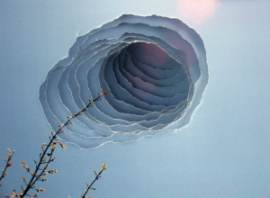Scott Hazard’s photo constructs turn images into fabrications of depth and imagination.
The eye lingers not only on the image, but in the image, as though something is waiting deeper inside.
Interview by Rosecrans Baldwin
Scott Hazard is an artist and landscape architect based in Raleigh, NC. He has exhibited his work at venues including the Second Street Gallery, Roanoke College, Goucher College, the Appleton Museum, the Atlantic Center for the Arts, Artspace in Raleigh, NC, and Artspace in Richmond, Va. He was born in San Diego, Calif., and received his landscape architecture education at California Polytechnic State University at San Luis Obispo. He earned a Master of Fine Arts with an emphasis on sculpture, photography, and video at the University of Florida.

Are these pictures photography or sculpture? Does it matter?
Hazard:Historically I have considered these pieces as sculpture. I’m most concerned with creating physical spaces using the layers of images to articulate a presence in the photograph that may or may not be initially apparent. The pieces work to make vision tactile by inviting the viewer’s gaze to move layer by layer through the physical space in front of them as well as the space captured in the image. I’m very intrigued by the notion of looking at and through something at the same time.
The difference between the two is mattering less and less. Recently, I have become interested with opportunities of presenting the photographs of the photo constructs as work in their own right and as extensions of the original pieces. For several years I have been focused on the physical 3D object. I am now seeing a world of potential in photographing the physical photo constructs to create images that still ultimately draw the viewer into the work and evoke a presence and experience similar to that found in the physical 3D object.

How do you feel when you learn that a picture in the media’s been manipulated in Photoshop?
Hazard:Typically I don’t mind the use of image editing software in images presented to the public. People are using Photoshop and similar software to create some very compelling art that can ultimately challenge and stretch our understandings of the world we live in. All images are constructs and reflect a point of view regardless of how much they are manipulated. We see and experience the world through lenses tinted with our own ideas and expectations. In this sense an image manipulated using image editing software can enhance the event or subject portrayed in order to reinforce the intent or content of the image, or the image can me manipulated to mislead. I’m only really concerned when images in the news media are altered to mislead.
I am inherently low-tech and prefer minimally enhanced images for my own work. Photoshop is an an essential tool in my work for simple image editing but I don’t typically use the software to alter the content of the images.

Walk us through how one of these photo constructs come about.
Hazard:My work focuses on aspects of urban and pastoral landscapes so I begin with shooting in various locations, usually urban environments which have had some time to age and exhibit signs of natural or cultural evolution. I focus on simple details and work to compose a very flat image without a lot of inherent depth. From dozens and dozens of images I select a few that appear to have the potential to need or have room for a space to explore, or contain an element that can be highlighted. Then I sketch different sculptural voids to determine what can best mesh with the image. Occasionally I create a simple maquette using printed images and cardboard to refine the void. I color, edit, and size the images in Photoshop prior to printing proofs and archival prints, and then build the frame/box. I work layer by layer with the images and carefully tear and compile to begin to shape the void in the photo construct. Last, I photograph the piece to document it.


Any young/emerging artists that you’re particularly excited about?Hazard: I’m very enthusiastic about what is next from Kymia Nawabi, Jason Mitcham, Tory Wright, Lisa Iglesias, Shane Mecklenburger, and Leah Frankel.


